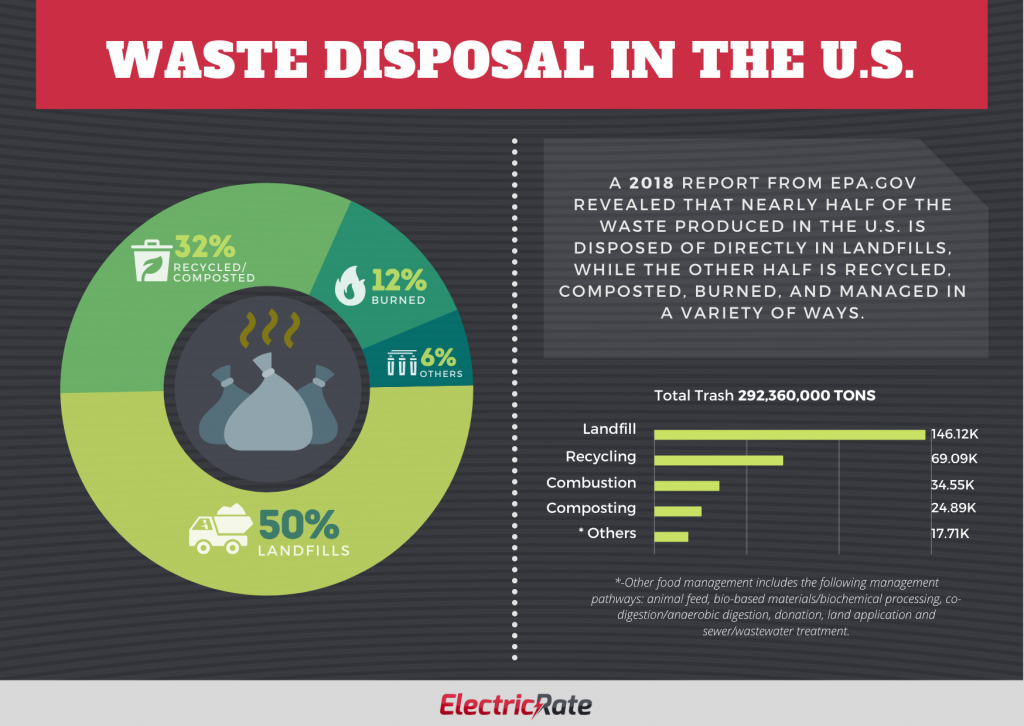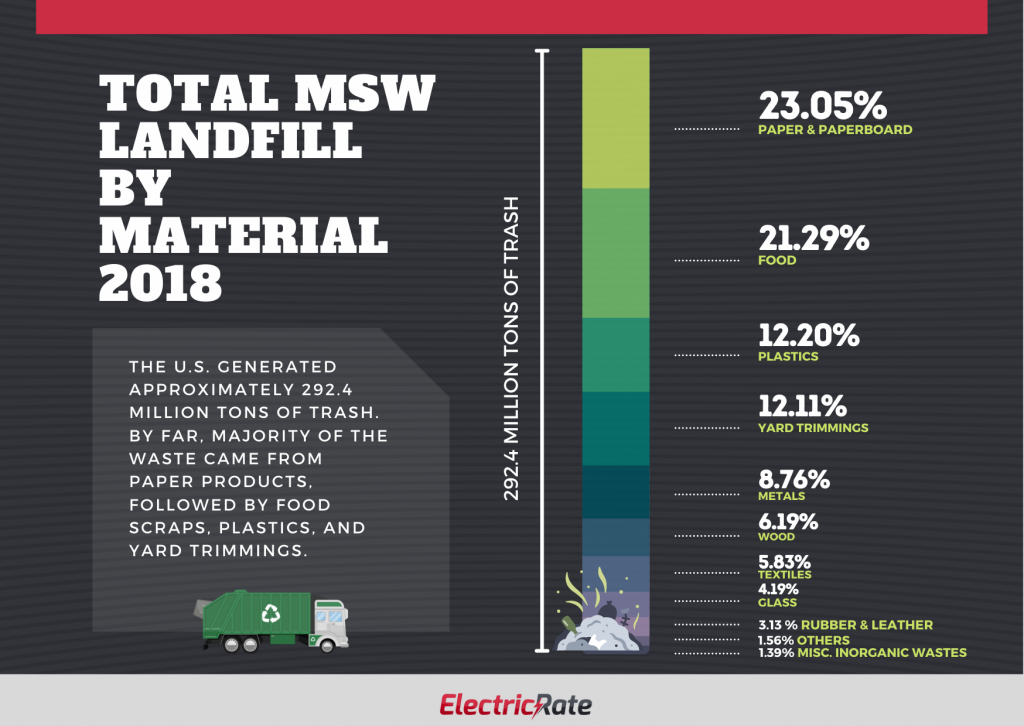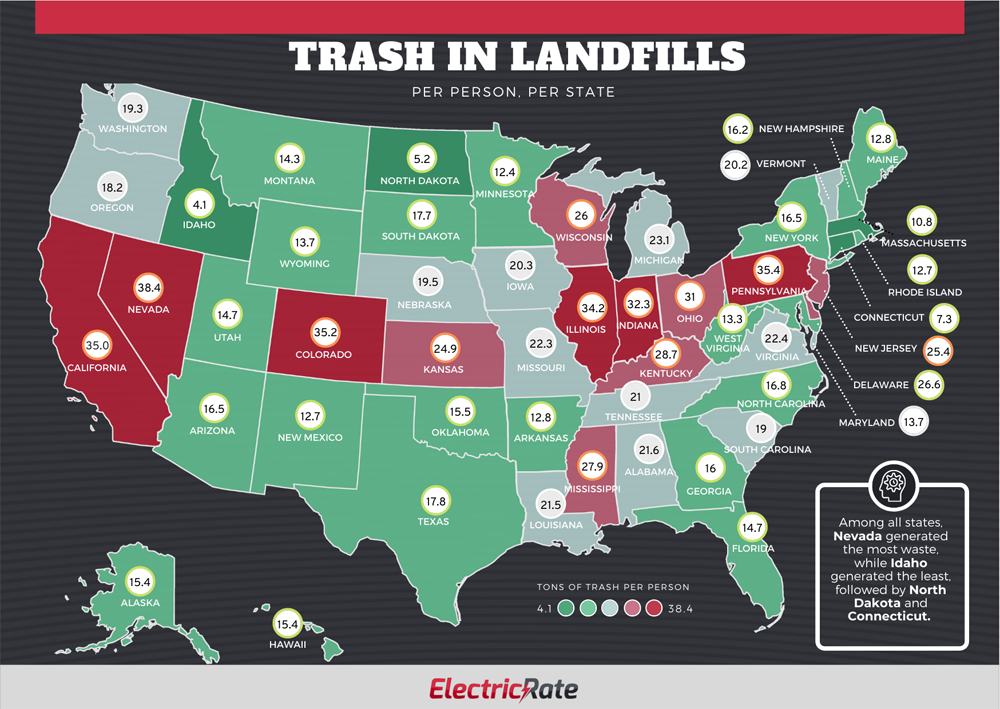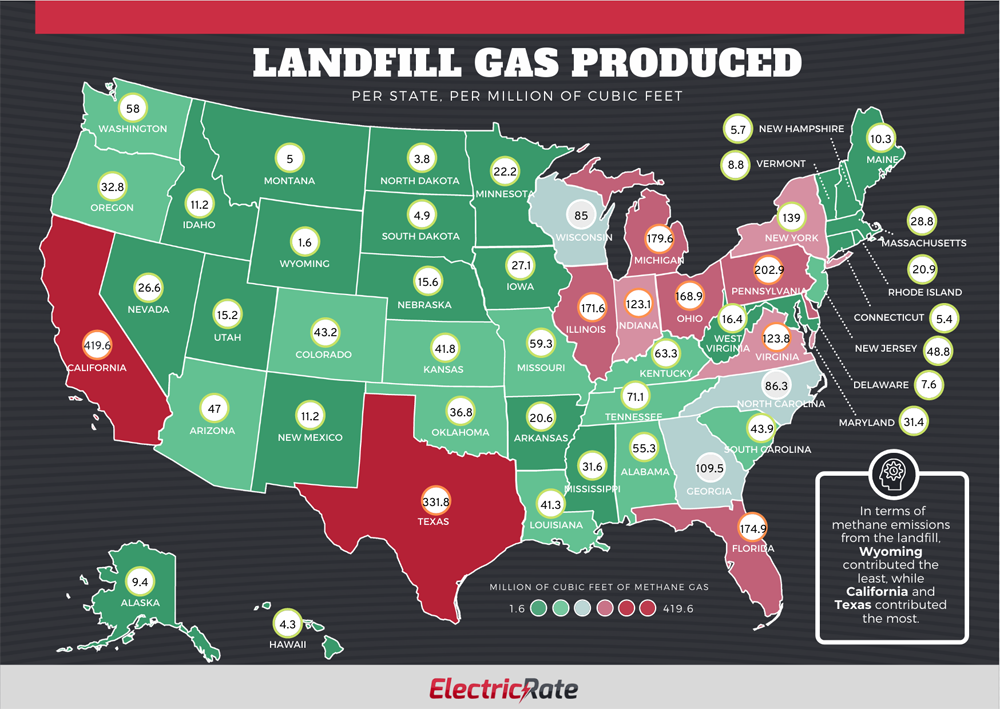Do you Know What Happens When a Landfill is Full?

America has got a waste problem. An average American produces about 4.40 pounds of garbage per day and approximately three-quarters of a tonne per year. If you are thinking “this can’t possibly be right, there is no way I produce THAT MUCH”, get ready for another blow. The U.S.A holds the record of producing the highest amount of garbage in the world, more than Russia, India, and even China.
All that trash has to end up somewhere and as a result, the 2,000 active landfills in the US are reaching their capacity. What will happen when we run out of the room? Well, let’s ask a better question. What can we do to manage our waste better and prevent a catastrophe?
Overfilled landfills are a big problem. Some states decide to simply burn the landfills, as burning reduces the volume of the trash in the landfill significantly. This frees up a lot of space, but the problem of toxic gasses and fumes being released into the atmosphere persists. Not only do these gasses contribute to climate change, but they can also deteriorate human health and end up costing millions in medical expenses.
On the other hand, simply leaving the landfills as they pose other issues. The chemical and biological reactions taking place in landfills can create a lot of issues as these chemicals leach into the ground and contaminate water that municipalities may extract for use in their water systems. The piles of organic garbage also release harmful methane, a greenhouse gas more 86 times more potent than carbon dioxide. So, what can be done to alleviate these issues?
Landfills in the US
How is the produced trash disposed of? According to the United States Environmental Protection Agency (EPA), about 32 percent of the trash is recycled or composted, 12 percent is burned and 50 percent is buried in landfills.
Considering the early practices of simply discarding the trash by throwing it in rivers, the amount of trash that is recycled or composted is very encouraging. More trash is recycled than ever, but additional efforts, especially in plastic recycling and energy recovery need to be made to ensure that the planet we live in is a clean and a safe place.

In 2017, that converted in approximately 139.6 million tons of waste being landfilled in the U.S. What materials are most often found in landfill sites? Food scraps were the largest component at about 22 percent, followed by plastics, paper, and paperboard, rubber, leather, and textiles.
The biggest contributor to the volume of landfills was food scraps and other food waste, such as supermarket discards. The best thing to do with this type of waste is to divert it to aerobic digestors, which can turn it into a rich compost for use in fields and gardens. The biggest side-product of this practice is heat, which many American farmers have used for decades to heat their homes and farms for free.
Another great way to reduce the amount of food, paper and cardboard that goes to the landfills is to send it to anaerobic digestors. These digestors produce little heat, but the anaerobic microorganisms that break down organic matter rather create methane. Although this gas is a big contributor to climate change, it can also be purified and used instead of gas in our cars and agricultural machinery. The rest of the organic matter is turned into humus, a rich addition to our soils and gardens.

Source: United States Environmental Protection Agency (EPA)
There are large disparities in waste management across each U.S. state. Approximately one-quarter of all U.S. landfills are situated in the country’s west. California is covered in landfill sites – there are 13 in the Los Angeles area alone. On the other hand, Indiana, Michigan, Ohio, and Illinois have the highest rate of filling up landfill sites, each year adding approximately 2 tonnes of new land waste per capita to their sites.
What happens when a state produces more garbage than what it can accommodate in its landfill sites? One such example is New York where The Big Apple alone generates more than 14 million tonnes of garbage a year and spends around $2.3bn disposing of it, often as far away as in Alabama. New Yorkers aren’t the only ones. The trash trade is a $4 billion industry, so many states are happy enough to accommodate other states’ disposals.
The United States is also home to thousands of inactive landfills, many of which have been repurposed as parks and public spaces.
Landfill Evolution
In the past, most Americans lived in sparsely populated rural farming communities, burning the majority of their solid waste in open dumps. Some of the waste didn’t end up being burned but started to accumulate in these open dumps – the world’s early landfill sites – with no effort to compact or cover up the waste.
Over the years, landfill sites have improved in design, regulation, and capacity. Modern landfills are constructed with a clay or plastic lining to contain leachate, with trash compacted in order to increase stability, and covered to prevent any attraction of pests.
The Trash in Landfills Per Person, By State
And now the moment of truth – which state produces the highest amount of garbage per person? The answer might surprise you – it’s Nevada. Apparently, Nevada is not only home to the City of Sin (Las Vegas), but also to the highest average amount of landfill waste per capita – a staggering 38.4 tonnes per capita. On the other side of the spectrum is Idaho, with only a negligible 4.1 tonnes of garbage per person. How do you keep it so clean, Idaho?

The Danger of Landfill Gases
You might be asking – alright, I get it but what’s wrong with accumulating waste in landfills? Well, the sad news is that a million-ton waste pile doesn’t create only an esthetic problem, but also an environmental one. The bacterial decomposition of organic material, such as food waste results in the emissions of both methane and carbon dioxide.
You are probably familiar with carbon dioxide, as a harmful greenhouse gas that is generated for example by burning coal. But it’s methane that the scientists trying to solve America’s landfill gas problem are worrying about.
In the first two decades after its release, methane is 84 times more potent than carbon dioxide. While methane doesn’t linger as long in the atmosphere as carbon dioxide, it is initially far more devastating to the climate because of how effectively it absorbs heat. And there is plenty of reasons to worry –a recently published extensive research led by EDF uncovered 60% more methane emissions between the years of 2012 – 2018, than originally estimated by the government, amounting to an approximately $2 billion issue.

| U.S. State | Trash in landfills (tonnes per person) | Landfill gas produced by state (MMSCFD*) |
|---|---|---|
| Nevada | 38.4 | 26.6 |
| Pennsylvania | 35.4 | 202.9 |
| Colorado | 35.2 | 43.2 |
| California | 35 | 419.6 |
| Illinois | 34.2 | 171.6 |
| Indiana | 32.3 | 123.1 |
| Ohio | 31 | 168.9 |
| Kentucky | 28.7 | 63.3 |
| Mississippi | 27.9 | 31.6 |
| Delaware | 26.6 | 7.6 |
| Wisconsin | 26 | 85 |
| New Jersey | 25.4 | 48.8 |
| Kansas | 24.9 | 41.8 |
| Michigan | 23.1 | 179.6 |
| Virginia | 22.4 | 123.8 |
| Missouri | 22.3 | 59.3 |
| Alabama | 21.6 | 55.3 |
| Louisiana | 21.5 | 41.3 |
| Tennessee | 21 | 71.1 |
| Iowa | 20.3 | 27.1 |
| Vermont | 20.2 | 8.8 |
| Nebraska | 19.5 | 15.6 |
| Washington | 19.3 | 58 |
| South Carolina | 19 | 43.9 |
| Oregon | 18.2 | 32.8 |
| Texas | 17.8 | 331.8 |
| South Dakota | 17.7 | 4.9 |
| North Carolina | 16.8 | 86.3 |
| New York | 16.5 | 139 |
| Arizona | 16.5 | 47 |
| New Hampshire | 16.2 | 5.7 |
| Georgia | 16 | 109.5 |
| Oklahoma | 15.5 | 36.8 |
| Alaska | 15.4 | 9.4 |
| Hawaii | 15.4 | 4.3 |
| Florida | 14.7 | 174.9 |
| Utah | 14.7 | 15.2 |
| Montana | 14.3 | 5 |
| Maryland | 13.7 | 31.4 |
| Wyoming | 13.7 | 1.6 |
| West Virginia | 13.3 | 16.4 |
| Arkansas | 12.8 | 20.6 |
| Maine | 12.8 | 10.3 |
| New Mexico | 12.7 | 11.2 |
| Rhode Island | 12.7 | 20.9 |
| Minnesota | 12.4 | 22.2 |
| Massachusetts | 10.8 | 28.8 |
| Connecticut | 7.3 | 5.4 |
| North Dakota | 5.2 | 3.8 |
| Idaho | 4.1 | 11.2 |
*Millions of cubic feet of methane gas
Going Green – The Power of Recycling
At this point in the article, you are probably thinking “I am ready for some good news now.” Here it comes. According to the EPA, Americans in 2017 recycled or composted 94.2 million tons of yard waste, approximately 32.5%. Compared with only about 6% in the 1960s, America deserves a pat on the back for a job well done.
More specifically, sixty-six percent of discarded paper and cardboard was recycled, followed by 27 percent of glass and 8 percent of plastic materials in 2017. Another piece of good news is that the recycling industry has brought in nearly $17.5 billion into the US economy, generating approximately 40,000 jobs in 2017.
But there is still work to be done. To date, only 25 states have passed laws making state-wide electronic waste recycling mandatory. More than 60 million plastic bottles still find their way to landfills and incinerators every day.
Each of us can make small changes to our day-to-day routines and be a part of the solution, rather than the problem. If you haven’t yet, start recycling and make a difference to our planet!
FAQs
How much trash is in landfills?
According to the United States Environmental Protection Agency (EPA), about 55 percent of all garbage in the U.S. is buried in landfills, more than 139 million tons.
What happens to garbage in a landfill?
Landfill sites are not designed to break down the garbage, merely to bury it. Materials put in a landfill breaks down very slowly, thanks to the lack of oxygen and little moisture inside. Because of the lack of oxygen, the bacteria produce methane gas, which is highly flammable and dangerous if allowed to collect underground. It is also a potent greenhouse gas and contributes to global warming.
Will we run out of landfill space?
According to EPA, the current landfill capacity is sufficient at a national level, but there are some regions that are becoming more limited in their disposal options. Seven states are looking at running out of disposal space in the next five years, one state will reach capacity in five to 10 years and three states have 11 to 20 years to go. These states will be at the mercy of other U.S. states, willing to accommodate the produced waste.
Updated on
